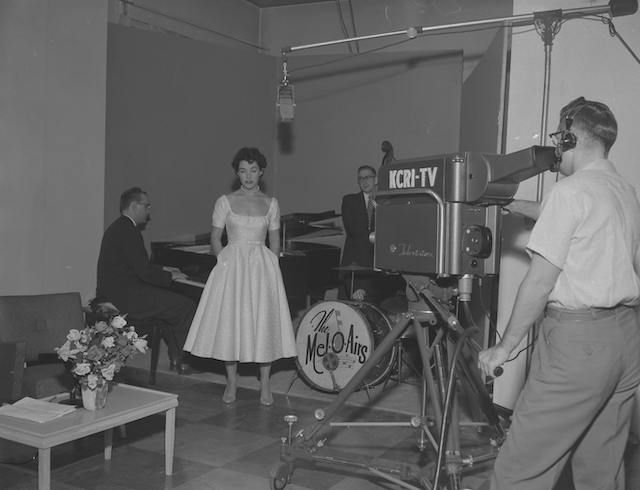
The musical group “The Mel-O-Airs” performs during Channel 9’s first year on the air. The Cedar Rapids station was known as KCRI only from 1953-1954; this photo shows the station’s original call letters on the camera. Photo courtesy of Jeff Stein
Sept/Oct 2023 (Volume 15, Issue 5)
By Jeff Stein
Today’s consumers of news and entertainment can find material through a variety of outlets, from television sets to computer screens. And they can select what they want to watch, when they want to watch it; no longer is a viewer limited by a station’s broadcast schedule, thanks to “video on demand” playback options online.
Given that backdrop, it’s hard to recall a time when the only “moving picture” source in a home was the grainy signal seen on a black and white television … and many areas of the country did not even have access to a local television source with a reliable signal.
Seven decades ago, that was the situation for those who wanted to watch television in eastern Iowa. But it all changed as quickly as one could turn a knob on those early TV receivers and switch the channel.
In the fall of 1953, eastern Iowans had no local television stations to call their own. The closest signals were single stations in Davenport and Ames; otherwise, if the atmosphere was cooperating, signals from Chicago, Ill., or Minneapolis, Minn., might appear. But by Thanksgiving of that year, the television picture had changed dramatically — literally.
In less than two months that fall, people in Cedar Rapids, Iowa City, Dubuque and Waterloo were served by not one … not two … but three stations originating broadcasts from new stations in the region. The timing of those stations taking to the air, and the stories behind their founding, are unique in U.S. media history.
Prior to World War II, television was only experimental. During the war, all work on the new medium stopped, but almost immediately after the war’s end, attention refocused on the promise of television. Radio’s success in assisting the war effort and informing citizens at home enhanced in the minds of many the promise of adding pictures to the sound they had been used to for a quarter-century to that point.
The crush of applications for new television stations quickly outpaced the Federal Communication Commission’s ability to respond. After granting only 108 licenses nationwide in the immediate post-war years, in 1948 the FCC imposed a freeze on approving license applications in order to sort out the situation. The freeze was intended to last only a few months, but in fact would last for nearly four years, while an impatient public waited.
Two Iowa-based television stations were approved to go on the air before the freeze. Just as his radio station was the first one licensed to operate as a commercial station in Iowa, B.J. Palmer’s WOC-TV in Davenport officially began broadcasting on Oct. 31, 1949, as the first television station in the state. Operating at the time on Channel 5, the station served the approximately 400 homes in the Quad Cities of Iowa and Illinois that had television sets at the time. Soon after, on Feb. 21, 1950, Iowa State College (now Iowa State University) signed on WOI-TV, which then operated on Channel 4. When the license freeze ended, a reallocation of frequencies bumped each station up one number on the VHF dial — to the more familiar channels 6 and 5, respectively.
TO READ THE ENTIRE STORY AND OTHER FASCINATING STORIES ABOUT IOWA HISTORY, subscribe to Iowa History Journal.
